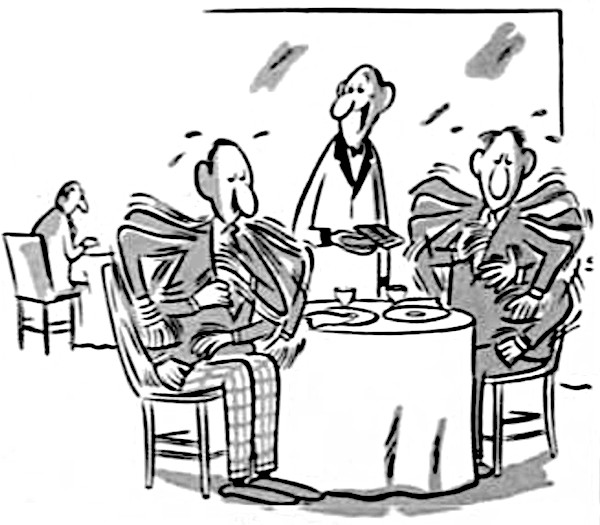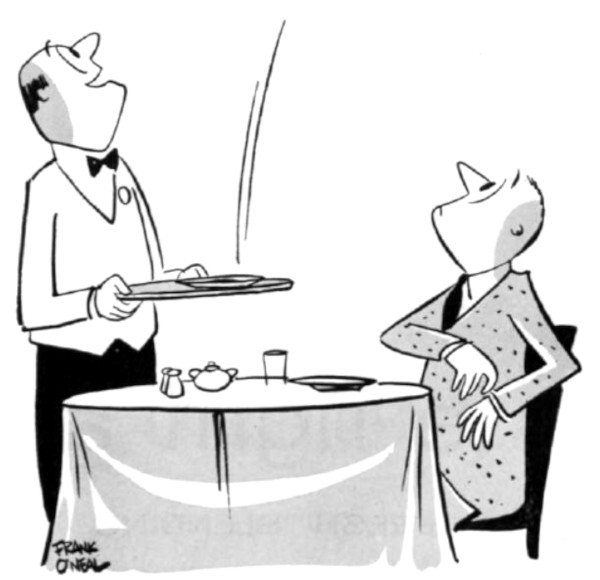Cartoons: Oh, Waiter!
Want even more laughs? Subscribe to the magazine for cartoons, art, inspiring stories, fiction, humor, and features from our archives.

Goldstein
June 9, 1951

Leo Garel
June 9 1951

Goldstein
June 2, 1951

Gardner Rea
June 2, 1951

Dan Q. Brown
May 21, 1955

Roy Fox
May 1, 1954

Gallagher
April 10, 1954

Tom Henderson
March 1, 1952

January 23, 1954

Frank O’Neal
July 16, 1955
Want even more laughs? Subscribe to the magazine for cartoons, art, inspiring stories, fiction, humor, and features from our archives.
The Lure of the Buffet
Of the manifold gifts we have received from Sweden — ABBA, full-body massage, and Ikea, among others — my favorite is the smorgasbord. Interestingly, it wasn’t until 1939 that smorgasbords, which originated in the 14th century, finally showed up on our shores, at the New York World’s Fair. Americans quickly embraced what Swedes had long enjoyed. The underlying concept — value and excess — played perfectly into our insatiable appetite for endless quantities of practically everything.
Naturally, it wasn’t long before smorgasbords found their way to Las Vegas, where casino owners understood the appeal of visitors bellying up to tables piled high with food before bellying up to gaming tables piled high with chips. “Those buffets are all about debauchery and abundance, so they fit right in with the gestalt of Las Vegas,” Jenny Eden Berk, a New England-based eating psychology coach, told me.
Even now, in the era of the coronavirus and social distancing, as many Americans lament the sleeker bodies they once had, all-you-can-eat buffets (essentially smorgasbords with a high-cal twist) remain popular staples along the Vegas Strip. It was undoubtedly in Sin City that millions of us first encountered tables heaving with row upon row of exotic-seeming seafoods, dim sum, enormous meat entrees, artisanal breads, egg confections, mystery soups, multi-veggie soufflés, creamed who-knows-what, and mousse-topped desserts half a foot tall. All brilliantly illuminated.
“Those buffets are all about debauchery and abundance, so they fit right in with the gestalt of Las Vegas.”
But away from Las Vegas, sadly, all-you-can-eat buffets are disappearing from our dining culture. They boomed until the ’80s, when we began a sharp pivot toward smarter eating. According to one market research report, as the number of restaurants in America increased by 22 percent since 1998, buffet establishments fell by 27 percent during the same period. Golden Corral is the last national buffet chain standing. Local all-you-can-eats, which charge, on average, about $20 per person, are few and far between these days. Lavish $70 spreads are available mostly at high-end hotels.
That’s too bad. Yes, I know, enormous buffets can trick us into frenzy-eating, but they can also be pleasurable in a way that eating at a traditional sit-down restaurant sometimes is not. For instance, if you’re like me, you feel no loss in occasionally bypassing the “fine-dining experience,” which can entail faux-fancy menus, haughty waiters, and apologies for food that “we’re so sorry got burned.” At buffets, no burned food!
Also not a lot of great food. What you find may include aging mayo-based salads (susceptible to contamination), cream-based pasta dishes (packed with saturated fat), fried foods (cooked in cheap oils), and plenty of sprouts (often tinged with bacteria). It’s well known in the industry that buffets are frequently where food scraps land. You may not fall deathly ill, but quality can be dicey.
You do need to restrain yourself, though. Examples abound of customers who abused the privilege, such as a 350-pound Wisconsin man tossed from an establishment after consuming a dozen fried fish fillets. And a woman who was removed from a Golden Corral after downing every one of the available brownies. C’mon, folks — all I ask is that you use napkins and utensils and try not to embarrass our species.
Otherwise, have at it. Eating coach Jenny Eden Berk, speaking in defense of beleaguered buffets, told me: “If you eat there consciously, you can give your taste buds foods that are spicy, savory, and sweet. We need all that variety. It helps start the digestive process.”
Fantastic, I say. No one could possibly oppose the unalloyed joy of healthy digestion!
In the last issue, Cable Neuhaus wrote about swimming pools.
This article is featured in the July/August 2020 issue of The Saturday Evening Post. Subscribe to the magazine for more art, inspiring stories, fiction, humor, and features from our archives.
Featured image: Shutterstock
The Blue Lobster
THE BLUE LOBSTER
1980 – Harpswell, Maine
John Nelson and I were lobster shopping for our dinner at “Bibbers” out on the point. Bibber called us over to a saltwater tank off by itself, away from the many others churning with ordinary “reds.”
“One in a million,” he said. “No, actually, make that one in every TWO million, accordin’ to the latest survey.”
Indeed! The only lobster at Bibber’s place with its own private condo was a living, gill-fluttering cobalt blue lobster, as rare as a cave painting of Gomorrah’s senior prom date.
“I’ve only had 6 others like this one in my 30 years as a colorful, white-bearded, pipe-smoking New England lobster man,” said Bibber.
“What’s the fate of this old boy?” I asked Bibber.
“First off, it’s a she, not a he. Second, she’s still under 2 pound. Soon as I get her up to somewheres over 3, she’s off to the big city. You’ve heard of New York City? Well, that’s where she’s off to — a place called The Blue Lobster, an exclusive establishment known only to its very select members as ‘The B.L. Club.’”
Bibber went on to explain that he and only one other lobster merchant on the East Coast supply The B.L. Club with “blues.” Why? According to Bibber, “most other merchants are either unknowing of such a place or they’re too short-sighted or wrapped up in their work to bother separating the rare blues from their regular catch. Even if they knew about the money involved, why bother with solitary confinement — or working ‘em up to size — or packin’ ‘em up and havin’ to ship ‘em off special? Most figure that’s just too much trouble for … well, for whatever it’s worth, from a dollar standpoint. Too busy makin’ money to be makin’ even more! Some loony way of thinkin’, huh?”
“So, how much money are we looking at here?” I asked.
“None a’ your bee’s wax, sonny boy,” Bibber replied.
“What sort of place is this Blue Lobster?” Nelson asked. “Is it a zoo, or, like … a museum?”
Bibber smiled. He fired up his pipe and shinnied up onto the edge of the table supporting the blue lobster’s tank. “The Blue Lobster, my friends, is a restaurant. That’s right, it’s a restaurant, and one like no other. But even more so, it’s an elite society, one in which only very, very few people have ever gained tenure.”
“So,” I said, “you go there and you eat a blue lobster! What’s the big deal? They gotta taste the same as red ones, right?”
Nelson shot me a reproving look. “It’s the idea of eating something so rare … isn’t that it Mr. Bibber?” he said.
Bibber shrugged. “You tell me. All I know, is, they been in business near as long as me, they’re rakin’ in the semoles big time, twenty, fifty, maybe a hun’ert times what I bring in workin’ my tookus off year after year.”
“This is crazy,” I said, eyeballing the blue lobster waving at us from between Bibber’s legs. “How much? How much for this baby right here, right now?”
“That depends, sonny. How much you willin’ to pay?”
“Fifty.”
“Thousand?”
That shut me up. A moment passed. Bibber vaulted off the table, scooped up a net full of detritus, flakes, algae and a half-eaten hot dog, and dumped it into the blue lobster’s private abode. He moved to another corner of the shop and we followed. After a while, he said, ”The Blue Lobster opens for one night only, usually once or, occasionally, twice a year. There’s a waiting list of 200 names. Most of those folks know they’ll never get called, not in their lifetimes but, nevertheless, just bein’ on the list is considered a real status symbol. And, a’course, bein’ Number 15 carries much more weight than 16, and so forth.”
“Tell us more,” said Nelson, scowling at me to keep my mouth shut.
“As soon as a blue lobster becomes available, the restaurant contacts the lucky duck at the top of the list. That person’s notified that his or her ‘blue’ will be served with all the trimmin’s at 8:00 p.m. on thus-and-such a date. The person writes out a check for the full amount … ”
“How much is it?” Nelson asked politely.
“I’m told it’s gone up as high a hun’ert thou. Yep, that’s the last amount I heard, one hun’ert thousan’ smackaronies. Anyways, that person sends a check to the owner, shows up on the predetermined date and heartily, hungrily devours the most expensive lobster dinner in the universe. I guess for some folks, that’s the ultimate! When you think of it –- one in every two million bugs and only a wee percent of that for the eatin’. Not to mention – the souvenir! Good Golly, those souvenirs alone might be worth twice the cost of that meal in no time at all!”
“What’s the ‘souvenir,’ the guy’s bowel movement?” I said, receiving an elbow in the ribs from Nelson.
“It’s a baby-blue tie-on bib with a blue lobster hand-stitched into it. Linen or silk, somethin’ like that. Talk about your status symbol! They say that all 9 people who’ve eaten there have their bibs mounted on the most prominent walls in their homes … estates … … mansions … wherever. It’s not likely you’ll ever find one in a flea market or tag sale, that’s for darn sure.”
“So, who’s got those bibs?” Nelson asked.
“Oh, let’s see. The very first customer was some wealthy Russian oligarch, the same Roosky what bought Hitler’s 770K Mercedes.”
“Who else?” I asked.
“Uh, hm … Bob Hope, I think. Ivana Trump. Barbra Streisand, she’s one. Oh, and Old Blue Eyes, Frank Sumatra. There’s a man who’d rather die than eat a lobster; and so, as the story goes, he brought his friend Don Rickles along. Rickles ate the lobster and Old Blue Eyes kept the bib.”
Who paid?” I asked.
“Come on — who cares?” barked Nelson.
“Gentlemen, I’ve got a lot of work to do,” said Bibber. “What can I do ya’ for, today?”
FIVE-STAR RESTAURANT REVIEWS
A recently retired TV writer moved to New England where he applied for a job as a freelance journalist at his new hometown’s local newspaper. For his “trial writing assignment,” the job applicant is given this background information on the article he is to present:
–The nationally-acclaimed food critic, Sir Gladstone Wellington, having recently attended four of New England’s so called “five star” restaurants, is scheduled to address the Head Chefs of these establishments with a verbal evaluation of their respective diner gastronomiques. Additionally, our prospective freelance journalist has been informed that the four chefs’ expensive culinary presentations are categorically served “totem-pole” style, that is: virtual pyramids of foods served atop each other and, traditionally crowned with dramatic swirls of finely-pared ribbons of varying flora.
On the day of the scheduled address, the “auditioning” journalist is seated behind the four chefs at a local country club and joins them in applauding the famous Gladstone Wellington as he takes the stage and taps the live microphone. “It’s obvious to me,” Wellington begins, “that each of you takes great pride in the originality — the artistic ingenuity — with which you’ve chosen to present your dinner entrees.” (The chefs smile and wink at the attending journalist, obviously vying for glowing reviews).
“In fact,” Wellington continues, “I noticed that when your servers emerge from your kitchens brandishing these New-England-styled sculptures of food, patrons’ heads swivel around as if watching a fashion show; they gasp and even appear to salivate as each elegant objet d’art is paraded throughout your respective establishments. I even overheard one elderly lady say to her husband, ‘My goodness, Harvey, is that your dinner or Carmen Miranda’s hat?”
The writer begins scribbling in his notepad as Sir Wellington continues speaking. “At this time,” he says, “I’d like those of you who consider these ‘haute style’ ceremonious servings to be the key element of running a successful restaurant, to kindly declare yourselves by raising your hands.”
Four hands shoot straight up while the writer continues note-taking.
“Duly noted,” says Wellington, cupping his chin. “Let me conclude with this observation: I couldn’t help noticing that, once they’ve been served, your patrons, using available utensils, laboriously begin dismantling your ‘creations.’ After scraping those ornate little curlicues to one side, your customers begin rescuing their respective slabs of meat or fish from the potato mattresses into which they’ve been squashed, surgically scraping the potatoes off the undersides of their meats, then proceed salvaging or even attempting to recognize whatever vegetables lay matted like soggy doormats under those potatoes. Finally, after separating the foods on their plates, and having sampled and usually rejected the sauces you’ve much-too-generously splashed on, your diners begin to eat and, as often as not, or shall I say most often, soon come to realize that the quality of the actual food they’ve been served is sub-standard — desiccated beef and fish; shoe-leather slabs of week-old lamb; duck medallions with the consistency of toilet plungers; lobster tails and shrimp tougher than a motorman’s glove. It’s as if one’s gorgeous dance partner at a Masquerade Ball removes his or her mask at the end of the night only to reveal the hideous visage of a shriveled, ancient mummy!”
After a stunned silence, one chef holds his breath until his face takes on the pallor of overly-boiled pot roast; two silently weep tears saltier than reconstituted consommé, and the fourth chef simply wilts like the herbs topping his priciest main courses.
The auditioning writer turns in what he’s written the next day, amusing the editor by renaming the four restaurants — The Gyp Joint, BASTA fazool, Can You Dig It?, & Something’s Fishy, — and clinches a staff job with the title of his article: “Just Desserts.”
Featured image: Shutterstock